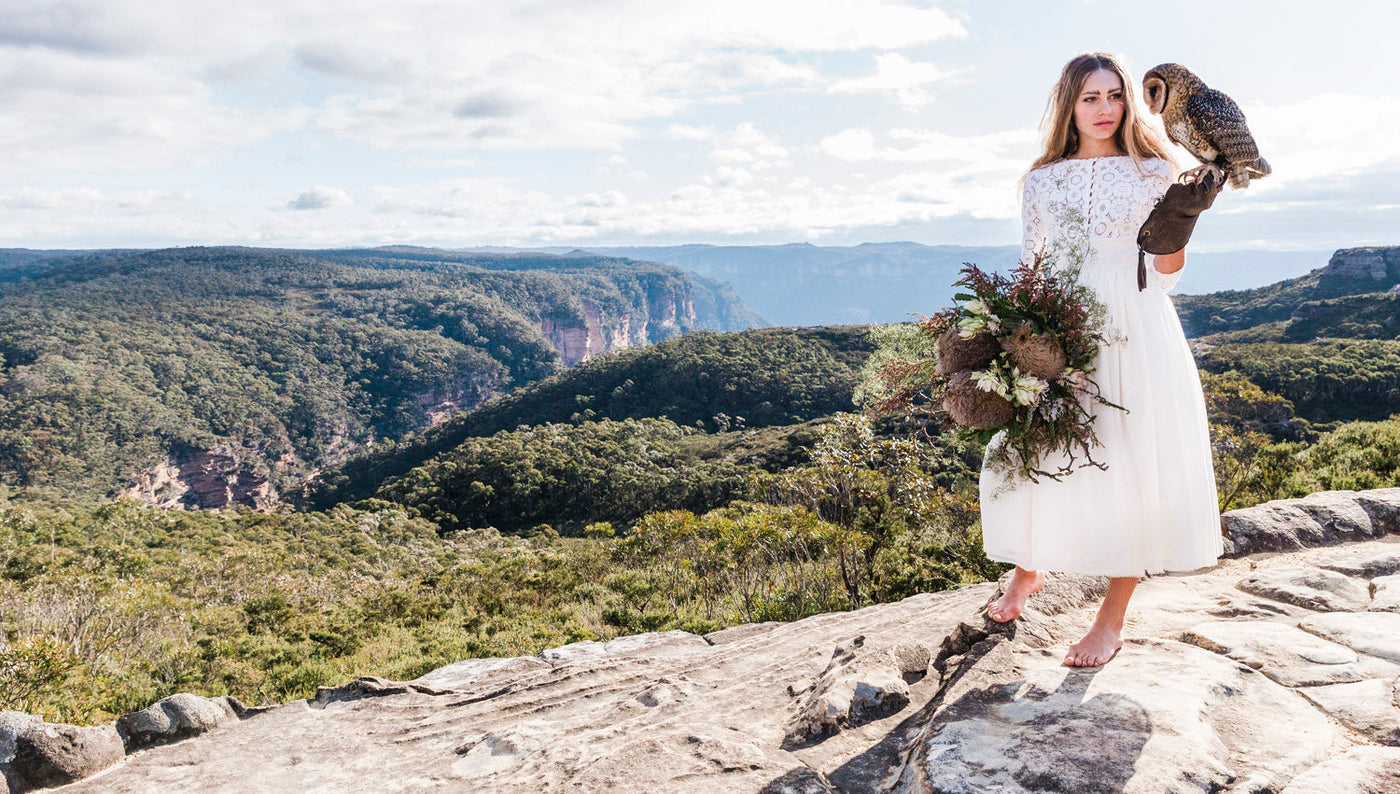Your Cart is Empty


Photo by Tim Williams
Have you been searching for a wedding dress but are struggling to determine whether or not a dress has been sustainably and ethically made? It's not an easy process; non-transparent supply chains make this task almost impossible.
The manufacturing of a brand new wedding dress on average, creates between 20 and 30 kg of CO2 and uses over 10,000 litres of water. For a dress that is likely to be worn only once, your choice can have a significant environmental impact.
When shopping for your wedding dress we encourage you to ask how and where it was made.

Photo by Geoff Beatty
A wedding dress with the least environmental impact will be a dress which has been worn before. Take a peek into your mother's or grandmother's wardrobe.
Bride Lauren asked us to refashion her mother's wedding dress.

If you are unable to find a suitable vintage dress then the next best option is to purchase a dress made from vintage fabric. On average, 60% of the carbon footprint of a brand new wedding dress lies in the manufacturing of the fabric, so upcycling existing fabric will provide you with significant environmental savings.
Our dresses are handcrafted from vintage fabrics such as silk shawls, lace veils, curtains and bedspreads. By reusing materials which already exist in the the world we are significantly reducing your carbon footprint, and saving thousands of litres of water.

When nylon is made, the process releases nitrous oxide, a greenhouse gas that is 300 times more potent than carbon dioxide. To minimise your environmental impact, avoid nylon, polyester and acrylic, as they are derived from fossil fuels.
We source vintage fabrics which are made from natural fibres only, such as silk and cotton. This means that your dress will be biodegradable and compostable, so it will eventually return to mother earth, rather than disintegrate into micro-plastics, as synthetic fibres do.
The thread we use to stitch together your dress is made from organic cotton. Even the zippers we use are made from recycled plastic.

Photo by Thom Stewart
Where was the dress made? Where was the fabric manufactured? Were the working conditions safe? Was the pay fair? 90% of all wedding dresses are made in China, often under questionable working conditions.
Our dresses are ethically handcrafted entirely in our atelier in Sydney, Australia. There are no sweatshops or other dirty little secrets behind our collection.
The new silk we use to make our slips and dress linings is certified by the OEKO-TEX® "Made in Green" label. This means the silk has been tested for harmful substances and is manufactured in environmentally friendly facilities with socially responsible working conditions.


Photo by Tilly Roberts
Our dresses are made-to-order or made in small batches, rather than mass-produced. This allows us to minimise any fabric waste so that nothing goes into landfill. Large lace scraps are reused in patchwork dresses such as our zero-waste Edwardian dress. Smaller scraps go into our compost bin where the worms and micro-organisms transform it into soil within 12 months.

Photo by Eric Ronald
You've heard of single-use plastics, but what about single-use dresses? Sadly, the fate of most wedding dresses is to be worn only once.
We encourage you to wear your wedding dress again and again. Our non-traditional, casual designs allow you to reimagine your dress into your everyday wardrobe. Or allow us refashion your dress for you, by shortening the hemline or dyeing it another colour (using eco-friendly, non-reactive dyes).
Alternatively, why not resell your dress to another bride-to-be? Many of our brides have sold their Lost in Paris dresses on stillwhite.com.au

Danielle re-wearing her Unbridled wedding dress

Photo by Brown Paper Parcel
By making wedding dresses from vintage fabrics for more than a decade, we have saved over 20 tonnes of CO2 and 10 million litres of water. It's time to give ourselves a hearty pat on the back!
We at Lost in Paris are here to help you tread more gently on our mother earth. To choose a wedding dress you can feel good about, visit our online store here.

| Size | Bust | Waist | Hip |
|---|---|---|---|
| XS | 85cm | 65cm | 94cm |
| S | 90cm | 70cm | 99cm |
| M | 95cm | 75cm | 104cm |
| L | 100cm | 80cm | 109cm |
| XL | 105cm | 85cm | 114cm |
| XXL | 110cm | 90cm | 119cm |
| XXXL | 115cm | 95cm | 124cm |
| XXXXL | 120cm | 100cm | 129cm |
How to measure yourself to determine your size:
Bust: Measure around the fullest part of your bust, wearing your bra.
Waist: Measure around the narrowest part of your waist, above your navel.
Hip: Measure the fullest part of your hips, around your buttocks.